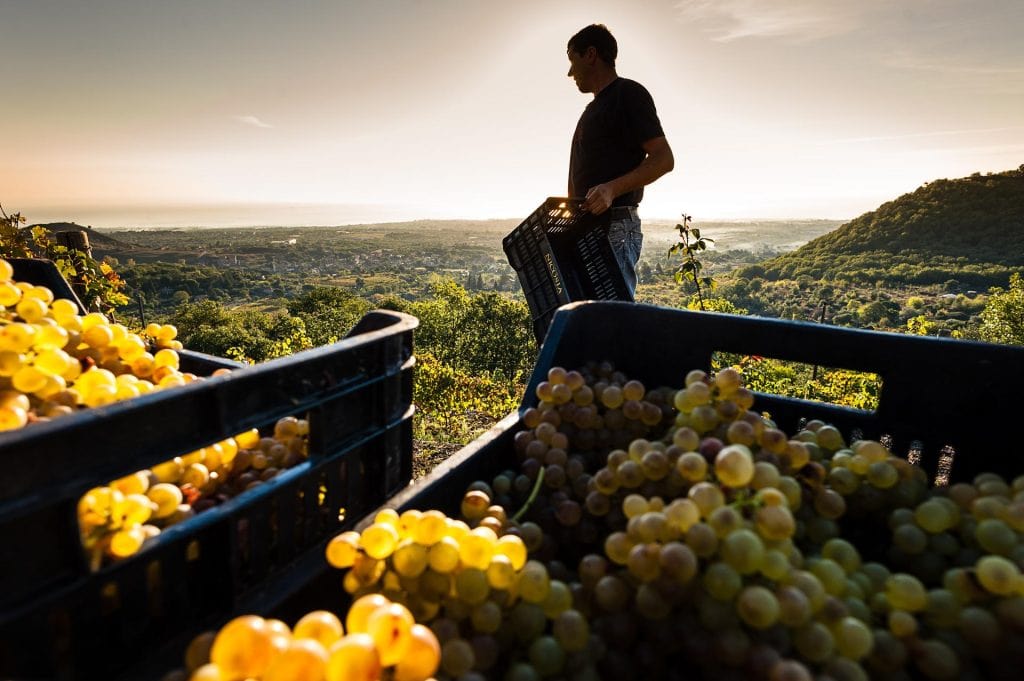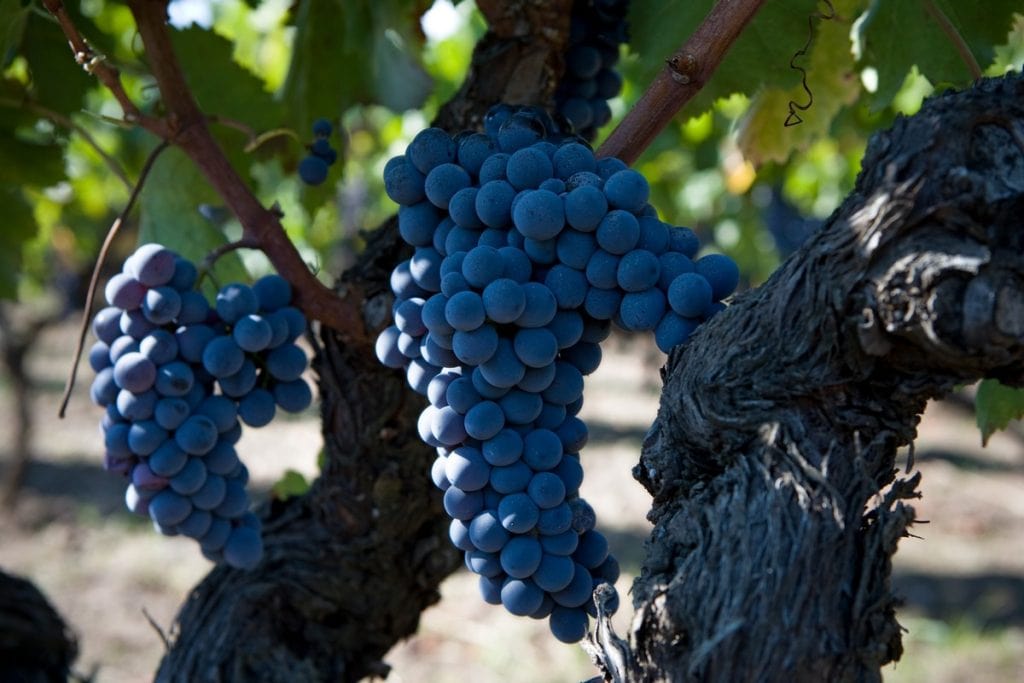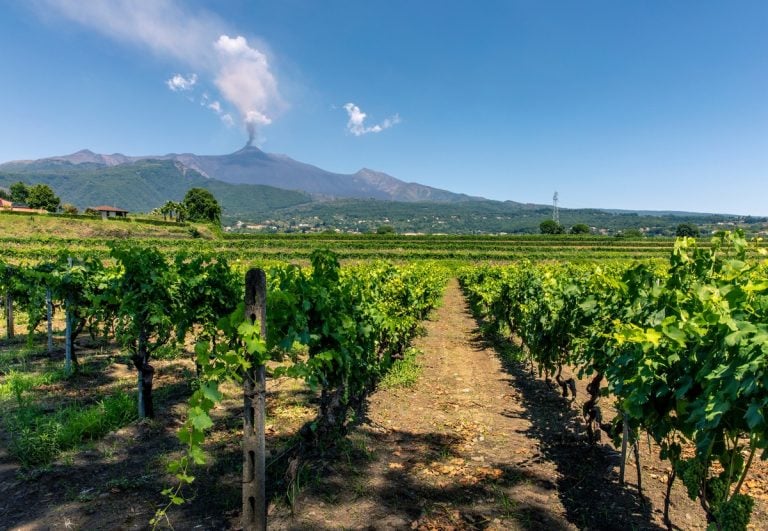Year by year, Sicily continues to display an extraordinary dynamism, allowing it to establish itself in both the Italian and international markets (not only with reds but now with whites as well). Here, we focus on Etna wines, a remarkable district that fell into oblivion for years but was among the first to be discovered and recognised by us. Of the 28 wines awarded Tre Bicchieri this year, almost half are from Etna (9 reds and 3 whites)—memorable labels that confirm this terroir's vocation for viticulture.

Etna wines, as noted, shine especially in red varieties, with nine wines earning top honours (including Frank Cornelissen’s Munjebel Rosso MC, released without a designation), yet the quality of the three awarded whites is equally impressive. One of these is produced by the Emerging Winery of 2025 for the Gambero Rosso 2025 Vini d’Italia guide: Maugeri.

Renato Maugeri with his daughters Carla, Paola e Michela
Etna wines: characteristics and grape varieties
Etna wines are elegant, profound, nuanced, and expressive of their territory: rich in all those qualities that have turned them into a true legend in markets around the world. The primary grape varieties include Nerello Mascalese and Nerello Cappuccio for reds, and Carricante and Catarratto for whites, with the latter, long underrated due to a lack of appreciation for its value, now flourishing in western Sicily. Numerous labels have captivated our committees with their flavour, complexity, longevity, and personality. This variety, long centred mainly in the vast Alcamo area, has also led to an active movement around “natural wines,” brought to the forefront by the so-called "Catarratto boys," who are now enjoying well-deserved success.
Four Etna wines are featured in the 'Carta dei Vini Rari', a brand-new section of just 50 labels found in the Gambero Rosso 2025 Vini d’Italia guide, also the focus of the November issue’s cover story of Gambero Rosso: Etna Bianco Sup. Palmento Caselle '20 - I Vigneri; Etna Bianco Sup. Kudos '19 - Curtaz; Etna Rosso San Lorenzo Piano delle Colombe '21 - Girolamo Russo; Etna Rosso Signum Aetnae '15 - Firriato.

The best Etna wines awarded Tre Bicchieri
Here are the 12 Etna wines (both reds and whites) that received top recognition in the *Gambero Rosso* 2025 *Vini d’Italia* guide.
Etna Bianco Alta Mora 2023 by Alta Mora boasts intense and elegant notes of white peach and citrus blossom, with a delightful palate showing flavourful tension, minerality, and a lingering finish. In 2013, Diego and Alberto Cusumano contributed significantly to Etna's terroir by establishing a stand-alone entity focused on expressing the unique characteristics of individual vineyards—selecting crus in the best-suited areas. In their subterranean winery in Verzella, integrated seamlessly into the surrounding landscape, they vinify exclusively indigenous raw materials from the same contrada: Guardiola, Pietramarina, Feudo di Mezzo, and Solicchiata.
Etna Bianco Muganazzi 2022 by Graci is a captivating wine, remarkable for its finesse and elegance, with hints of broom, saturn peach, wisteria, jasmine, and medicinal herbs over a graphite background; on the palate, it has a vertical acidity balanced by surprising texture and enjoyable drinkability.
Alberto Aiello Graci’s wines demonstrate an unparalleled expression of volcanic terroir, with labels from different contradas where local cultivars respond distinctively to varying exposures, soils, and vine ages. This pursuit of diversity is complemented by the use of concrete tanks and large, truncated-cone oak barrels. The winery’s unmistakable style has made it a benchmark for both critics and wine lovers.
Etna Bianco Sup. Contrada Volpare 2023 by Maugeri—awarded as Emerging Winery, one of the 12 Special Awards of 2025—displays all the refined complexity of the Carricante grape, harmonious and vibrant on the palate, supported by a perfect balance between acidity and sapidity.
Renato Maugeri, with daughters Carla, Paola, and Michela, manages the winery located in Contrada Volpare in the commune of Milo, at an altitude of 700 metres on the volcano's eastern slope. In this area, overlooking the Ionian Sea, they cultivate five hectares of terraced vines around an 18th-century palmento. The terraces, framed by typical dry-stone lava walls, are mostly planted with Carricante, with a few Catarratto vines as well; soon they will double the vineyard, having recently acquired a couple more hectares of old vines in the nearby Contrada Rinazzo.
Etna Rosso Contrada Monte Ilice 2022 by Barone di Villagrande, made from Nerello Mascalese and other native varieties, perfectly expresses the volcanic terroir: it has aromas alternating floral and red fruit notes, with balsamic and smoky accents. Elegant and balanced on the palate, it leaves a persistent cherry flavour and a wonderfully fresh, velvety tannin structure.
Barone di Villagrande’s first wine label dates back to 1727, and the winery has always remained in the steady hands of the Nicolosi Asmundo family, now led by Marco, a talented winemaker. The estate is in Contrada Villagrande, a unique location for producing Etna Bianco Superiore. Today, they have also built a small relais within the winery, offering an enchanting view over the first historic Carricante vineyard and investing in a venture on the island of Salina.
Etna Rosso Contrada Pietrarizzo 2021 by Francesco Tornatore exemplifies varietal expression with notes of peach, blood orange, liquorice, and smoky hints; it is austere but clear and elegant on the palate.
Francesco Tornatore, a dynamic entrepreneur, has invested significantly in the northern Etna area, where he owns over 70 hectares of vineyards and two wineries, marking a return to his roots in Castiglione di Sicilia, where he began his successful career assisting his father in running the family farm. The wine produced in Contrada Trimarchisa, in the vineyard around his father’s palmento, is now his flagship wine.
Etna Rosso Contrada Zottorinoto Ris. 2020 by Cottanera shows extreme olfactory elegance, with a bouquet of blackberries, mineral suggestions, and smoky notes; the palate has remarkable energy and a long finish.
Founded by Guglielmo and Enzo Cambria, Cottanera quickly became a leading figure in the Etna wine revival: initially oriented toward international varieties like Syrah, Merlot, and Mondeuse, which thrived here, the focus gradually shifted to native grapes and the potential of single vineyards. The estate now boasts an important presence in the most prestigious Etna contradas.
Etna Rosso Erse 1911 Contrada Moscamento 2020 by Tenuta di Fessina is a wine of great calibre and personality, with a deep ruby hue veering toward garnet. It has hints of wormwood, red peach, black fruit, pink pepper, and tobacco, elegant and very refined on the palate, showing velvety tannins and a juicy, engaging character. Inheriting the spirit and inspirations of her late mother Silvia Maestrelli, a Tuscan producer with a profound love for Etna, Lavinia Silva now oversees the winery with Benedetto Alessandro, a highly talented winemaker.
Etna Rosso Lenza di Munti 720 slm 2021 by Cantine Nicosia, an exemplary wine of typicity and Etna terroir, is refined, profound, and marked by beautiful mulberry, blackberry, and blackcurrant fruit tones, crossed by hints of slate, violet, and black spices; it is authoritative on the palate, with a dense structure underscored by soft, vibrant tannins.
The Etna Rosso Mofete '21 from Palmento Costanzo claims the top spot with an intense and well-defined nose featuring notes of peach, red rose, and violet, highlighted by an elegant mineral character and a rounded, juicy fruit profile that is well-balanced and persistent.
Fifteen years ago, Mimmo and Valeria Costanzo restored an expansive, ancient palmento in Santo Spirito, carrying out exemplary renovations that preserved its original operational design, using gravity to move raw materials without mechanical interventions. The grapes, cultivated entirely organically, come from prestigious crus known for the lineage and age of their vines in the Santo Spirito, Feudi di Mezzo, Zottorinoto, and Bragaseggi districts in the northern region, and Cavaliere in the southwest.
The Etna Rosso Qubba '22 from Monteleone, classic in its refined tones of florals and dark fruit, presents balsamic and tobacco notes. Exceptionally elegant on the palate, it is both rich and slender. In an Etna DOC that is notably crowded, the very young Giulia Monteleone’s winery has, within a mere five years, rightfully earned its place among those that best represent the volcano. This success is due to a careful and meticulous management of the vineyards, which are personally overseen by Giulia and her husband Benedetto Alessandro, one of Sicily’s most talented oenologists; together, they personally oversee all stages of grape processing, both in the vineyard and the winery. The entire range, made up of elegant and terroir-driven Etna wines, shows impeccable craftsmanship.
The Etna Rosso Vigna Barbagalli '21 from Pietradolce is a wine of rare elegance and complexity, with distinct notes of bramble fruits, graphite, undergrowth, and scrub, dense, intense, and featuring refined tannins on the palate. In 2008, the winery by brothers Michele and Mario Faro made a stunning debut on our Guide, earning its first Tre Bicchieri with its initial marketed wine, the Etna Rosso Archineri '07. Much has changed since then: driven by the enthusiasm of their success, both critically and commercially, the Faro brothers have invested substantially, building a beautiful, high-tech winery that is perfectly integrated into the landscape, while simultaneously quadrupling the size of their vineyards, which now cover nearly 40 hectares across seven different districts.
The Munjebel Rosso Monte Colla '21 from Frank Cornelissen is an IGT from old Nerello Mascalese vines planted at nearly 800 metres of altitude. It is a deep and elegant wine, evoking notes of medicinal herbs, flat peach compote, bay leaf, and pomegranate; on the palate, it is complex with a mineral finish reminiscent of slate and graphite, and features soft, silky tannins. Frank, a true character, is renowned for his early discovery of the Etna area (dating back to 2001), as well as for his propensity to move beyond conventions and dogmas, experimenting and exploring, almost like a dowser, what was once a static and essentially unchanging world. His work could be summed up as "Cornelissen: Etna, beyond Etna." These internationally renowned wines interpret the volcanic area with originality and impeccable technique, captivating with their strong character and authenticity.


 US tariffs: here are the Italian wines most at risk, from Pinot Grigio to Chianti Classico
US tariffs: here are the Italian wines most at risk, from Pinot Grigio to Chianti Classico "With U.S. tariffs, buffalo mozzarella will cost almost double. We're ruined." The outburst of an Italian chef in Miami
"With U.S. tariffs, buffalo mozzarella will cost almost double. We're ruined." The outburst of an Italian chef in Miami "With US tariffs, extremely high risk for Italian wine: strike deals with buyers immediately to absorb extra costs." UIV’s proposal
"With US tariffs, extremely high risk for Italian wine: strike deals with buyers immediately to absorb extra costs." UIV’s proposal Meloni: "Tariffs? If necessary, there will be consequences. Heavy impact on agri-food sector"
Meloni: "Tariffs? If necessary, there will be consequences. Heavy impact on agri-food sector" The Government honours the greats of Italian cuisine, from Bottura to Pepe. Massari: "Thank you, Meloni, the only one who listened to us"
The Government honours the greats of Italian cuisine, from Bottura to Pepe. Massari: "Thank you, Meloni, the only one who listened to us"






